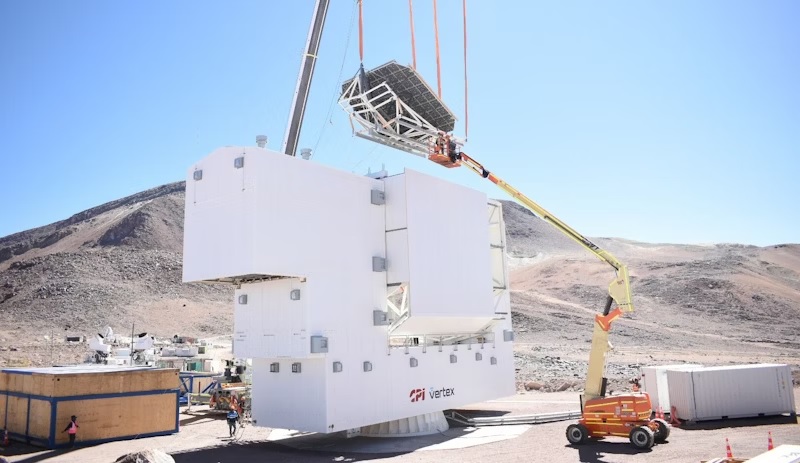A clearer look at the birth of the universe

In the Atacama Desert in Chile, a new telescope offers a closer look at the birth of the universe than ever before. The Simons Observatory Large Aperture Telescope (LAT) uses 100,000 detectors to observe the cosmic microwave background (CMB)— the afterglow of the big bang. The telescope’s assembly was finished this February, and it has now completed a successful test observation: the ‘first light’.
FSE Science Newsroom | Text René Fransen
Scientists from the Van Swinderen Institute (VSI) for Particle Physics and Gravity and the Kapteyn Institute for Astronomy of the University of Groningen will be involved in analysing the data provided by this new observatory over the next ten years.
Until now, the most advanced measurements of the CMB were made by the European Planck Space Telescope, between 2009 and 2013. The Simons Observatory is expected to be almost ten times more sensitive.

New physics
Observations made by the LAT provide information about the formation of the universe, because the CMB contains clues about the underlying physics of the Big Bang. At the time when this relic radiation was generated — not long after the Big Bang — processes were occurring at much higher energy levels than could ever be achieved in any man-built particle accelerator. The type of physics responsible for the production of this relic radiation has thus never been seen before. Cosmologists expect this background radiation to reveal specific patterns of new physics.
Daan Meerburg (VSI) is a senior advisory member of the team that will analyse the data and has been involved in this project from the beginning. The VSI will make significant contributions to the search for these patterns in data collected by the observatory.
The new observatory will also be able to measure—albeit indirectly—the temperature of gas surrounding galaxies and galaxy clusters. Astrophysicist Luca Di Mascolo of the Kapteyn Institute will use these data to refine models of galaxy formation. Consequently, the observatory will help us to gain a more complete understanding of the history of the universe, how its structure grew and evolved, and how it came to be as we see it today.
More information on the Simons Observatory website.
| Last modified: | 24 March 2025 09.59 a.m. |
More news
-
03 April 2025
IMChip and MimeCure in top 10 of the national Academic Startup Competition
Prof. Tamalika Banerjee’s startup IMChip and Prof. Erik Frijlink and Dr. Luke van der Koog’s startup MimeCure have made it into the top 10 of the national Academic Startup Competition.
-
01 April 2025
NSC’s electoral reform plan may have unwanted consequences
The new voting system, proposed by minister Uitermark, could jeopardize the fundamental principle of proportional representation, says Davide Grossi, Professor of Collective Decision Making and Computation at the University of Groningen
-
01 April 2025
'Diversity leads to better science'
In addition to her biological research on ageing, Hannah Dugdale also studies disparities relating to diversity in science. Thanks to the latter, she is one of the two 2024 laureates of the Athena Award, an NWO prize for successful and inspiring...
